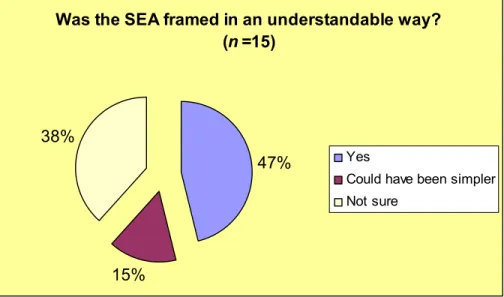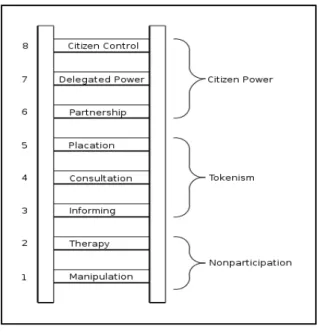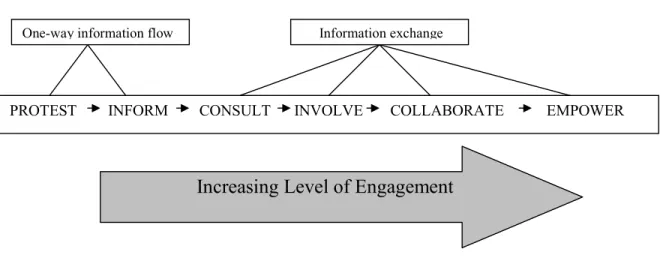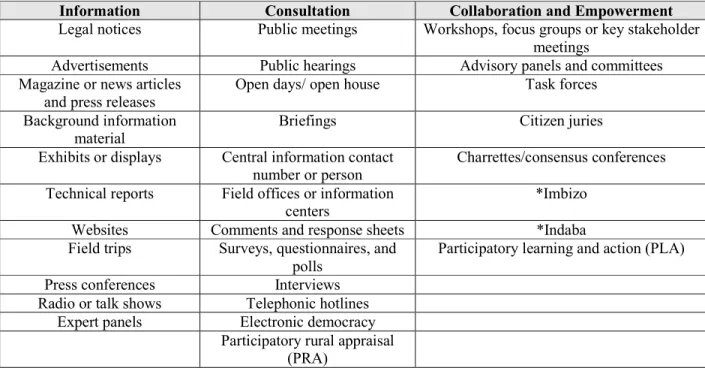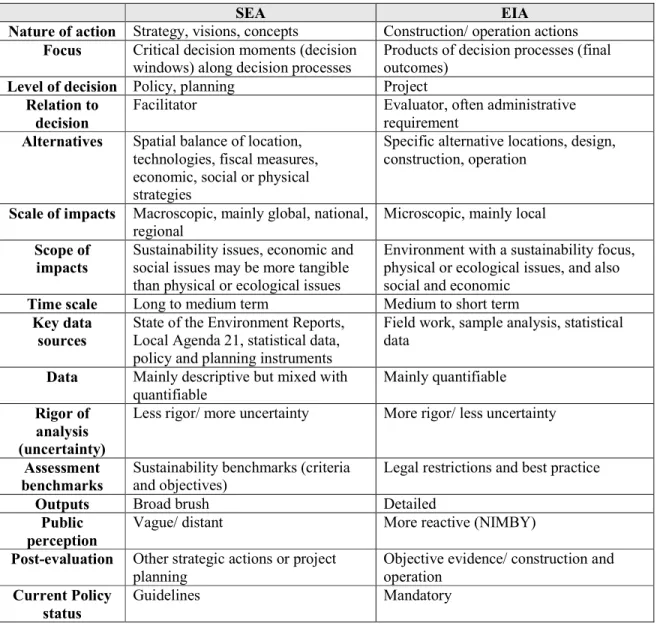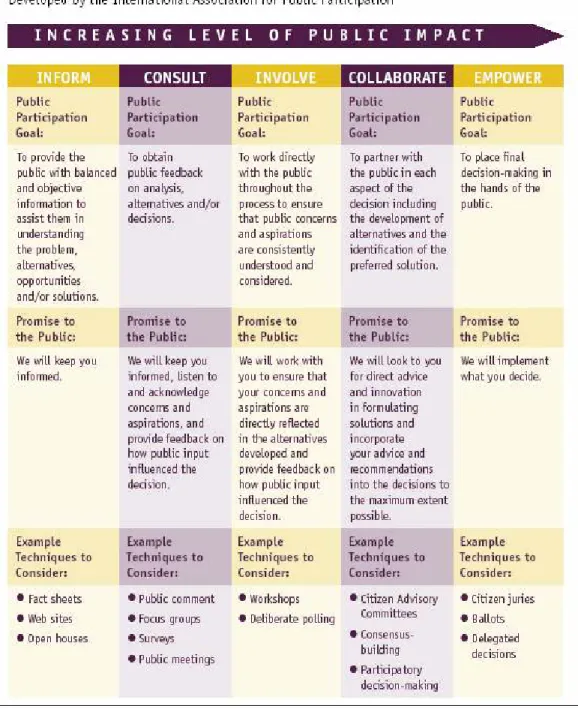As a result of this aim, most decision-making instruments include an element of public participation: a Strategic Environmental Assessment (SEA) is one such instrument. This study aimed to examine the governance processes within the draft SEA of the Mkhondeni Stream Catchment (MSC) area, with a particular focus on public participation. The first objective concerned an investigation into the processes of public participation as expressed in legislation.
The second objective involved an investigation of the public participation processes in the draft MSC area SEA. The third objective was to determine whether the 'deliberation' or public participation process was adequate. The fifth and final aim of this study was to reflect on the process of public participation and how it can be strengthened.
And finally, objective 5 is achieved if the public participation process within the draft SOV is reflected upon and recommendations are made. Appendix A – The differentiation of responsibilities for different actors in the actor engagement process (DECAS 2001).
Introduction
Currently the total population of the Ashburton area is still being determined through a census. This area for some of the residents and especially the PMMBT, is an area with considerable biodiversity but it is also an area that is under increasing development pressure and needs to be preserved. Thus, this research aims to examine the processes of public participation within the draft EIA of the MSC area.
The aim of the study was to investigate the management processes within the Draft Mkhondeni catchment SEA with specific reference to public participation. In light of the SEA process having no formal legislation or legislation for its public participation process, a reference can be made from the best practice recommendations set out in DEAT (2004) as well as from the nearest legislative environmental assessment instrument, i.e. SEA public participation process to be considered adequate, it must meet all or a majority of the best practice recommendations for the public involvement aspect of an SEA as indicated in DOT (2004) as well as a majority of the minimum requirements for public participation within an EIA.
An overview of the study area, discussion of the background to the study, and an overview of the aims and objectives of this study are provided. Finally, within chapter five, conclusions and recommendations are drawn to reflect on the public participation process and how it can be strengthened.
Literature Review
According to Beierle and Cayford (2002), “public participation” is defined as any method used to deliberately involve the general public, the population or key stakeholders in the decision-making process. The concept of public participation is one that has only recently been practiced democratically in South Africa. During the apartheid era, the majority of the population was excluded from the decision-making process.
As rightly stated by Khan (1998), although the principle of public participation is recognized as a vital part of the decision-making process, especially in relation to the environment and IEM, there is still a noticeable lack of proper implementation. Public participation allows the formation of a platform where there are open lines of communication between government and society. Two other major challenges related to the public participation process are those of communication and commitment to the process (Beierle and Konisky: 2000).
Given the many challenges facing public participation processes, there is literature suggesting that there are negative consequences associated with the presence of public participation. Public participation is seen as a problematic concept as there are different ways in which public participation takes place. One of the most prominent writers in this field is Arnstein (1969) who wrote an article entitled 'A Ladder of Public Participation'.
The involvement of I & APs in the decision-making process is often referred to as public participation. The International Association for Public Participation (IAP2 2000) describes public participation as a spectrum of increasing levels of public impact on decision-making (see Figure 4). For the purpose of this study, the concept of public participation will be used as it is more widely recognized and understood.
The Guide to Public Participation in South Africa by Greyling (2002) discusses some methods that can be used. Public participation according to Greyling (2002) can be done through written methods (such as letters, background information documents, print media and email), verbal methods (such as public meetings and focus groups) and stakeholder mailing lists (where each stakeholder is addressed personally) . Note was taken of the public participation process that took place in the compilation of the Draft MSK area SOW itself.
However, it must be noted that the public participation processes and SEA process must be adapted according to different contexts (Sadler and Veheem 1996). The concept of stakeholder engagement was looked at in contrast to that of public participation.

Methodology
The qualitative data was collected from key informants and this allowed for a better understanding of the factors and relationships that shaped the public participation process. The data collected from the study was firstly divided into themes, and then interpretive analysis was made to gain a better understanding of the collected data in relation to the theory underlying the study. An interview according to Kitchin and Tate is 'the most widely used qualitative technique', as it is a method that enables the researcher to produce data that is varied and rich in an informal setting.
According to Kitchin and Tate, interviews allow for 'a more thorough examination of the experiences, feelings and opinions that closed questions can never hope to capture'. This type of interview was considered the most appropriate for this study (Refer to Appendix C). The master copy of the list of stakeholders and affected parties (S&APs) in the Draft MSK area SEA annexes made it possible to determine who the key informants were and to contact them.
However, due to logistical reasons, only 6 of the 10 informants were interviewed (see Table 4). For the purposes of this study, they are assumed to represent the views of individuals who worked in the area, e.g. As a requirement for the Master's Program in Environment and Development at the Center for Environment, Agriculture and Development (CEAD), University of KwaZulu-Natal, eight students, including myself, were challenged in March 2007 to prepare a critical review of the draft. MSC area SEA.
The information gathered from the site visit and the site report provided a more in-depth examination of the draft MSC Area SEA because it allowed a critique of whether the draft MSC Area SEA document met the conditions. This gave a greater understanding of the different frameworks in which the draft MSC area SEA was presented. Purposive sampling was used to identify the main stakeholders involved in the public participation processes and in the preparation of the MSC area SEA, i.e.
They were selected for their role in relation to the SEA. sampling is '...the most important type of non-probability sampling...' and it aims to. intentionally obtain units of analysis in such a way that the sample obtained can be considered representative of the relevant population.' As further noted by Welman et al. however, the problem with this type of sampling is that different researchers may proceed in different ways to obtain such a sample and therefore it is impossible to evaluate to what extent such samples are representative of the relevant population. '. It was found that with some of the key informants initially identified for interviews, their current contact details were not available.

Analysis of Results
The use of print media in the SEA Mkhondeni draft case proved insufficient. Comments were allowed on the SEA for the Mkhondeni Stream catchment, particularly in relation to the preparation of the SEA report. All comments in the form of written submissions before the first draft SEA are attached to the draft SEA report.
One of the objectives within this study was to determine whether the deliberative or public participation process was sufficient. This position is reflected by the actions of the group in the case of the Draft MSC area SEA. As noted by the PMMBT Chairman (Respondent Three) the individuals represented were purely those of the property owners in the area.
This confusion may have played a role in the community's poor design of the SEA. Therefore, SEA is viewed negatively by the community due to disagreement over the size of the SEA area. The investigation into the public participation process within the Draft Mkhondeni Stream Catchment (MSC) area SEA formed the basis of this research.
The first objective was to investigate the public participation processes as expressed in legislation. The second objective concerned a study of the public participation processes of the Design MSC area SEA in particular. The first objective was to gain a better understanding of the legislation involved in the public participation process.
Mkhondeni's draft SEA report contained a record of all public participation practices that were carried out during the preparation of the report. Another issue that was controversial in the public participation process was public meetings. In thinking about the public participation process and how it could be strengthened, there are some elements of the SEA process that could be done more.
The management of the SEA process was generally found to be the most problematic within the draft Mkhondeni SEA. It is crucial in an SEA that the methods of public participation are adapted to the needs of the particular area.
